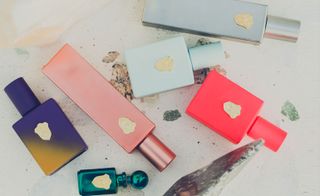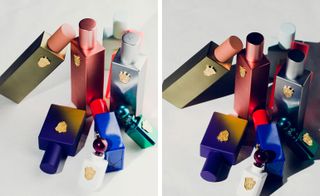Régime des Fleurs’ latest offering is available exclusively at The Line, a New York City-based online retailer of old and new. Titled “Mirror,” the fragrance is an intriguing blend of smoky guaiac wood, green galbanum, saffron, and violet, a harmonious fusion of masculine and feminine scents.
This floral-focused fragrance brand has been creating a buzz since it was founded in Los Angeles by Alia Raza and Ezra Woods in 2013. Driven by a shared interest in how flower essences work on many levels, the friends founded the company, which uses high concentrations of natural floral extracts to create exquisite scents.
The aesthetics of the early 1990s, the socio-cultural sentiment of the Ancien Régime and a shared nostalgia for classical mythology shaped the brand and inspired its first two collections: the first, the “Debut Collection”, explored in particular water and humidity (through the “refined luxury” of 18th and 20th century high modernism), while “Collection 2” focused on texture – “the evolving sense of touch”, a theme aimed at expressing the power of scent and how it evokes the past in the present.
The company’s fragrances are divided into three esoteric classifications: Lyrics, Ballads and Epics. The Lyrics (from Night Surf to Free World) are crisp, with watery notes and scents of petals and leaves, designed to capture the understated elegance of nature. The Ballads (such as Dove Grey and Belle Epoque) are more conceptual, while the sophisticated Epics (Nymphaea caerulea and Floralia) are crafted with precious and rare ingredients like blue lotus from India and Hawaii, Nile water lily headspace and white ambergris.
The elegant bottles were all designed by Raza & Woods, and the paints and coatings (some developed for motor racing and aviation) were chosen to evoke each scent and highlight the perfume’s “theme”: “Night Surf,” for example, recalls the neon flowers of Venice Beach at night, while the fluorescent safety orange bottle reflects not only an exaggerated orange blossom effect, but also the region’s youth culture in the late ’80s and early ’90s.

The brand creates its fragrances using natural flower extracts, enticing users with exquisite scents (and impressing with their exquisite packaging designs).
(Image courtesy of Press)

Offered in three esoteric classifications — “Lyric,” “Ballad” and “Epic” — the perfumes range from refreshing, watery blends to sophisticated uplifting scents, using rare ingredients such as the blue lotus of India.
(Image courtesy of Press)

Régime des Fleurs founders, designers and perfumers Alia Raza and Ezra Woods create beautiful fragrances inspired by the past.
(Image courtesy of Press)

